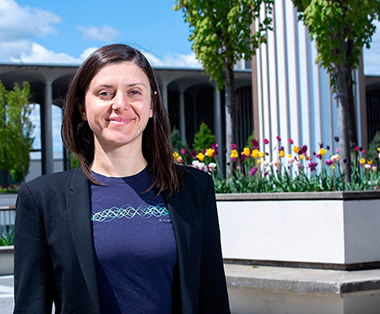UAlbany joining Notre Dame’s $25 million SpectrumX project

ALBANY, N.Y. (Sept. 16, 2021) — The University at Albany is joining forces with the University of Notre Dame and 27 other prestigious institutions to harness the power and potential of advanced radio technologies through the SpectrumX project.
Supported through $25 million in funding from the National Science Foundation (NSF) as part of its Spectrum Innovation Initiative, the project will explore ways to manage and advance the radio frequency spectrum — and its application as a driver of a host of wireless technologies, including 5G, GPS and mobile broadband.
“The forefront of spectrum research is at a stage where stakeholders from various disciplines, including computer science and engineering, climate sciences, physics, astronomy and others, have to come together to tackle emerging challenges in spectrum coexistence,” said Mariya Zheleva, assistant professor of computer science at the College of Engineering and Applied Sciences, who is leading UAlbany’s contribution to the project. “SpectrumX engages such a diverse community, and I am thrilled to be a part of the center and to collaboratively contribute to spectrum research and education.”

Zheleva is currently co-leading an NSF-supported partnership on National Radio Dynamic Zones. She also runs the UbiNET Summer School on Wireless for Undergrads, which will be expanded at the center level and will be delivered across participating institutions.
"We are especially gratified to see that Dr. Zheleva’s growing prominence in the critical area of spectrum research has been recognized with an invitation to join this effort led by the University of Notre Dame," said College of Engineering and Applied Sciences Dean Kim L. Boyer. "The radio frequency spectrum is a precious resource and the Spectrum X consortium is taking aim at the full suite of problems that must be confronted to wring the most out of it — and Mariya’s work is among the most important and exciting."
The explosion of wireless applications enabled by advanced radio technologies has placed access to a key natural resource, the radio frequency spectrum, at a premium. In the United States and around the world, radio frequencies are allocated to a variety of services such as mobile broadband, broadcasting and navigation (GPS) that are now mainstream and widely used. But the increasing demands of commercial wireless, especially 5G networks, as well as the greater needs of scientific, satellite and defense applications, among others, require paradigm shifts in management of the radio spectrum and in coordination of research and development around it.
To address these concerns, the University of Notre Dame-led SpectrumX project is bringing together experts from 28 other organizations to transform the landscape of spectrum research, education, collaboration and management.
“For the United States to continue unleashing spectrum at home and competing globally, we need a more national, interdisciplinary and proactive approach to pursue breakthroughs at many levels — in scientific receivers, spectrum sensing, coexistence and sharing mechanisms, cloud automation, and flexible licenses and enforcement,” said Nick Laneman, director of SpectrumX, co-director of Notre Dame’s Wireless Institute and professor of electrical engineering. “SpectrumX will pursue these innovations and create the world’s largest academic hub where all radio spectrum stakeholders can collaborate and contribute to maximizing the societal benefits provided by this precious resource.”
NSF has entered into agreements with the National Telecommunications and Information Administration, which regulates government use of the radio spectrum, and the Federal Communications Commission, which regulates non-government use of the spectrum, to help align investments in spectrum research, infrastructure and workforce development with U.S. spectrum regulatory and policy objectives, principles and strategies.
“It is our privilege to lend Notre Dame’s faculty expertise, research infrastructure and external partnerships to this important effort. The SpectrumX collaboration addresses the need for responsible and effective management of the radio frequency spectrum so that our generation and all that follow can continue to benefit from the wireless technology advancements so central to daily life,” said Marie Lynn Miranda, the Charles and Jill Fischer Provost at Notre Dame.
SpectrumX will also build a comprehensive education and workforce development program — starting in middle and high school classrooms and extending through undergraduate and graduate studies to prepare students in spectrum innovation, management and economic development.
“Congestion of the radio spectrum is a key challenge for science and for all sectors of society and the economy,” said Jonathan Williams, NSF program officer. “This SpectrumX NSF Spectrum Innovation Center will be a critical national hub for spectrum research and development to help overcome the challenges of interference and radio spectrum scarcity.”
In addition to Notre Dame and the University at Albany, SpectrumX partners include Agnes Scott College, Clemson University, Florida Agricultural and Mechanical University, Massachusetts Institute of Technology, Morehouse College, Morgan State University, the National Radio Astronomy Observatory, New Mexico Institute of Mining and Technology, New York University, Norfolk State University, Northwestern University, Olin College of Engineering, South Carolina State University, Spelman College, Stanford University, Texas Tech University, University of California Berkeley, University of California Los Angeles, University of California Santa Cruz, University of Colorado Boulder, University of Pittsburgh, University of Puerto Rico de Mayaguez, University of Texas at San Antonio, University of the Virgin Islands, University of Virginia, University of the West Indies and Virginia Diodes Inc.
For more information visit SpectrumX.org.




